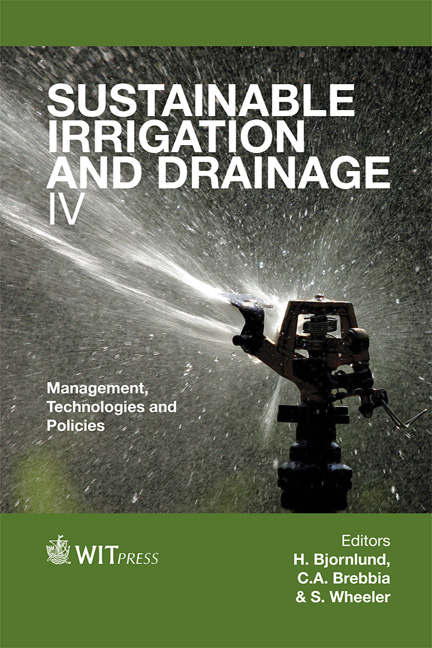Modelling The Impact Of Pulsing Of Drip Irrigation On The Water And Salinity Dynamics In Soil In Relation To Water Uptake By An Almond Tree
Price
Free (open access)
Transaction
Volume
168
Pages
13
Page Range
101 - 113
Published
2012
Size
619 kb
Paper DOI
10.2495/SI120091
Copyright
WIT Press
Author(s)
V. Phogat, M. A. Skewes, J. W. Cox & M. Mahadevan
Abstract
Pulsing is the application of daily irrigation in a phased manner involving one hour irrigation and one hour off. A field experiment was conducted involving pulsed and continuous irrigation to almonds through surface drip during 2009– 10, and water applications and moisture distribution in the soil were monitored throughout the season. A finite element numerical model (HYDRUS 2D) was used to evaluate the impact of pulsed application of irrigation on water balance and salinity distribution in the soil. The modelled values of moisture content matched well with the weekly measured neutron probe values at all soil depths (10 cm to 160 cm) with RMSE of mean values varying from 0.01 to 0.08 and 0.01 to 0.05 in pulsing (Ip) and continuous (Ic) treatments respectively. The simulated seasonal water uptake was slightly higher (25 mm) in pulsing than continuous irrigation, whereas the soil storage was slightly higher (20 mm) under continuous irrigation. The leaching fraction amounts to 0.25 in both treatments and was higher during August and March-April because the water requirement of almond early in the growing season and after harvest remained relatively low. The salinity distribution was similar in both treatments and simulated average salinity of soil solution varied from 0.47 to 3.38 dS/m and 0.49 to 3.67 dS/m in Ip and Ic treatments respectively. Hence the modelling simulations revealed that pulsed irrigation at higher discharge rate (3.87 l/h) produced similar water and salinity distribution in the soil as obtained in low discharge (2 l/h) continuous
Keywords
modelling, pulsing, almond, drip irrigation, moisture content, salinity, water uptake, leaching, HYDRUS 2D





